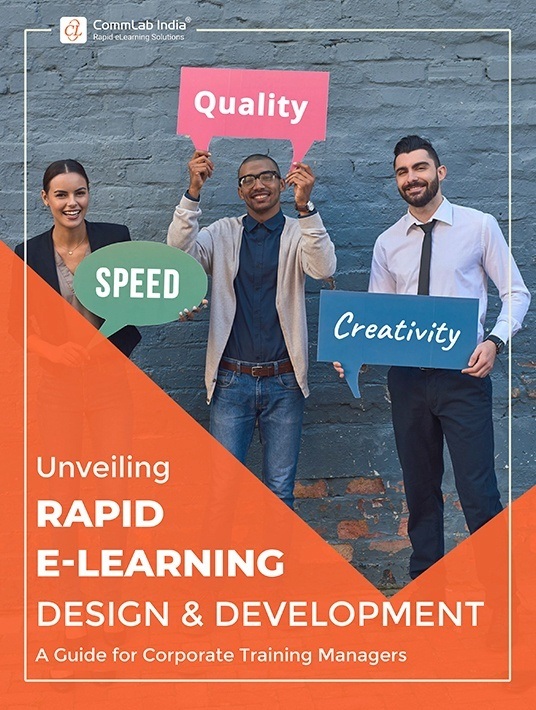What Rapid eLearning Is And What It's Not
What is Rapid eLearning? The variety of definitions and explanations that exist for this question will have you believe that the answer lies in the eyes of the beholder. For some, it means accelerating the eLearning design and development process by streamlining certain processes like storyboarding and prototyping. For others, it means quick training rollout and for a few others, rapid eLearning means authoring tools.
What Do You Think is Rapid eLearning?
A. Converting PowerPoint into eLearning using an authoring tool
B. Designing and developing eLearning courses real fast
C. Designing and developing eLearning courses real cheap
D. Courses with minimal or no instructional design
Let’s explore why it’s not A, nor C, or D. You can also download our eBook to learn all about rapid eLearning.

What IS Rapid eLearning?
The wait is over… Let’s discover what rapid eLearning is, exactly.
1. A Faster, Effective Avatar of Custom eLearning
Rapid eLearning is custom eLearning that cuts down on the time and cost invested.
Rapid eLearning offers this saving by:
- Following instructional design principles, cutting down on unnecessary bells and whistles
- Leveraging available content – classroom training material, legacy courses,
media elements, audio recordings, or videos - Using authoring tools and templates
- Adhering to agile, iterative project management
All this makes the eLearning design and development process faster and leaner. Apart from being a faster version of custom eLearning, rapid eLearning can be your best friend when you need to:
- Deliver training to a large group of employees within strict deadlines
- Translate training into multiple languages for uniform, consistent training across the organization
- Create training on content that has a low shelf-life or needs regular updates
2. Completely Aligned To Business Goals
Rapid eLearning courses are based on performance-based learning objectives, which in turn are aligned with the business goals. Learning objectives are set right at the planning stage and verified by Subject Matter Experts (SMEs) so that stakeholders and the L&D team are on the same page. This avoids any confusion and errors later in the process. It also sets the stage for how the entire course will be designed in terms of content, instructional design, interactivity, and assessments.
3. A Time-saving Option For SMEs
Getting SMEs involved in eLearning design and development is always a challenge because training is not their primary responsibility and getting their time for reviews can be next to impossible.
But with rapid eLearning, SMEs are involved right at the beginning of the project so that you can get all relevant information from them. You can also familiarize them with the process and agree on where and when they can be approached for reviews. This way you can schedule their time beforehand according to their convenience.
You can also make use of online course review apps of rapid authoring tools to provide SMEs access to the storyboards, prototypes, and courses on a digital platform to make the review process hassle-free.
What ISN’T Rapid eLearning?
Now that we have more or less understood the truth behind rapid eLearning, let’s go into what it isn’t. Because that’s where a lot of confusion and misinformation is.
1. A Shortcut That Compromises On Quality
It is commonly believed that it’s impossible to have all three – short timelines, cost effectiveness, and quality. Since rapid eLearning promises to reduce the time and cost of eLearning development, it is automatically assumed that there will be compromises on quality in terms of engagement and interactivity. But nothing could be farther from the truth.
Rapid eLearning doesn’t compromise on the quality of eLearning because it is based on robust instructional design principles.
In fact, you must take a lot of care to ensure rapid eLearning courses are instructionally sound.
- The primary content is carefully analyzed by the L&D team with the help of SMEs to set clear performance-based learning objectives that are aligned to business goals.
- Instructional design strategies are decided based on the content and type of audience.
- A prototype is provided for stakeholders to get a feel of the course and provide feedback.
- The content, design, and assessments are decided based on adult learning principles.
Besides, these so-called time-saving ‘short-cuts’ are miles away from ‘cutting corners’. They cut short the process of eLearning design and development by streamlining the planning and design processes. For example, by:
- Involving SMEs in the initial stages and getting as much information as possible right at the start, reducing the margin for error later.
- Following an agile course development process where the planning, design, and development occur concurrently.
- Using built-in interactivities and templates in authoring tools that reduces the time and effort needed to develop them from scratch using coding and programming.
2. Monotonous Courses Without Creativity Or Engagement
Another commonly held misconception about rapid eLearning is that the courses are glorified PPT decks with little or no interactivity. Well… it is true that complex interactivities are often avoided in rapid eLearning but that is only because complex interactivities need more time and cost to be developed.
But that doesn’t mean courses developed with rapid eLearning are mere click-next slides and videos. The problem is most people equate creativity and engagement with complex interactivities, when in fact, engagement actually depends on new-age learning strategies for which rapid eLearning offers a lot of scope.
Here’s how you can do that.
- Use scenarios, case-studies, and comic strips to engage learners through storytelling.
- Use icebreakers at the beginning of the course to grab learners’ attention.
- Personalize courses by asking learners to: Type in their names at the start of the course and address them by name throughout the course & choose from different avatars/roles based on their jobs
- Use gamified formative assessments to increase learner motivation.
Conclusion
Understanding what rapid eLearning is or isn’t is not as complicated as it sounds. Simply put, rapid eLearning is an approach that focuses entirely on the learning goals (after all, it strictly follows instructional design principles), doing away with all the extraneous and irrelevant things that usually clutter up eLearning.
Download the eBook Unveiling Rapid eLearning Design And Development – A Guide For Corporate Training Managers to find the right tools and techniques to leverage rapid eLearning for your organization. You can also join the webinar to master the essentials of high-impact learning.
References:
The WHY, WHAT, & HOW of Rapid eLearning Solutions

